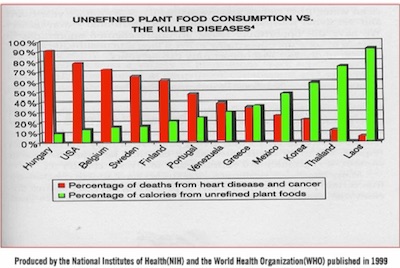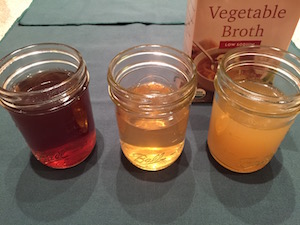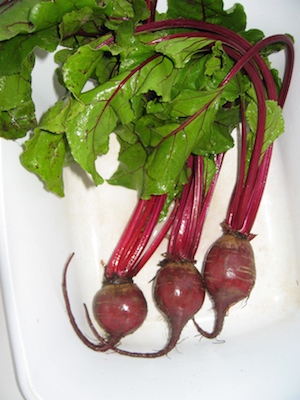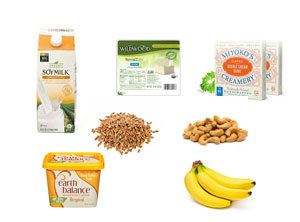
by plant4health | Mar 6, 2015 | Nutrition, Plant-based, Vegan, WFPB, Whole food, Whole food, plant-based
Doug Lisle, Ph.D. is a psychologist and co-author of The Pleasure Trap – Mastering the Hidden Force that Undermines Health and Happiness along with Alan Goldhamer. I had the “pleasure” of listening to a lecture by Dr. Lisle as part of the coursework I am taking to earn a certification in plant-based nutrition through Cornell’s online university, eCornell. Here are the key take-aways of Dr. Lisle’s lecture.
Most of us have been educated and quite frankly bombarded with messages about how to live a healthy lifestyle. When it comes to diet we know that eating more fruits and veggies is good and that we should avoid highly processed foods, sugar, the wrong kinds of fats, etc. Even though we know this information and may have a strong desire to follow a healthy diet, we find ourselves eating or drinking the wrong foods and beverages. Why is that?
(more…)
![Eating Healthy: Overcoming the “Cooking Obstacle”]()
by plant4health | Mar 2, 2015 | grocery shopping, Nutrition, Whole food
 The most common excuses I hear for not eating healthier are: “I don’t have time”, “I don’t like cooking”, and “I’m an awful cook”. These are the excuses of modern life.
The most common excuses I hear for not eating healthier are: “I don’t have time”, “I don’t like cooking”, and “I’m an awful cook”. These are the excuses of modern life.
We are so busy rushing from here to there that time has become a precious commodity. Additionally, our taste buds, conditioned to prefer heavily sugared and processed foods, are unaccustomed to the natural flavors of real whole foods. This perpetuates the fear that healthy cooking wont taste good. Compounded with the fact that most of us were raised on convenience foods and not taught basic cooking skills as children, cooking has become a foreign experience instead of second nature.
As a result, one of the biggest obstacles to eating healthy is cooking. The perception that cooking is a burden and a chore has become an epidemic. Cooking requires you to stop and focus on your physical needs and be creative as you combine flavors and textures to produce tasty combinations. Our society places more value on the immediate gratification of food fulfillment, overlooking not only the health benefits of cooking your own meals, but the pleasure that can be found in taking the time to prepare and share a healthy delicious meal. (more…)

by plant4health | Feb 27, 2015 | Plant-based, Recipes, Vegan
Vegetable broth is handy to have on hand for making rice dishes, risotto, and soups. It’s convenient to buy at the store but be sure to look carefully at the ingredients. Some list carrots as the first ingredient and the broth can be orange in color and very sweet. Some manufacturers such as Whole Foods brand add a bit of sugar and oil which is best to avoid. Trader Joe’s Organic Hearty Vegetable Broth has carrots as the first ingredient but does not add sugar or oil. Try a few brands to see what you prefer.
Of course the best broth is what you make from scratch. It’s not difficult, just takes a bit of advanced planning. But it’s worth it. You can control how intense you want the flavors to be and design it for the dish you are making.
A time-saving (and money-saving) tip is to save clean vegetable trimmings in a gallon freezer bag as you are cooking other meals or making salads. You can use theses scraps that would otherwise get composted to make broth. Save onion and shallot peels and the ends of leeks and green onions; carrot and potato peels, ends of celery (and their leaves), chard stems and bell pepper. In a separate bag save mushroom ends. You’ll add the mushrooms if you want a darker, earthier flavor, especially if you are making a mushroom risotto. You can also add fennel which will give a licorice flavor. Avoid cruciferous veggies such as broccoli and cabbage as they will add a bitter taste. Red beets will turn it red.
You can make a broth using just the scraps plus herbs (see recipe below) or add additional vegetables which you can roast or sauté first if you want a more intense flavor. Here is a wonderful basic broth recipe from Anna Thomas, featured on Epicureous.
For a broth just from the scraps, use this recipe from thegardenofeating.org:
- Place 4-6 cups of scraps in a soup pot or dutch oven and add
- 1 bay leaf
- 3-5 cloves of garlic, peeled
- 4 branches of Italian parsley
- A sprig of thyme or 1 teaspoon dried thyme
- Cover with water, about an inch above the veggies, bring to a boil and simmer uncovered for about 45 minutes.
- Strain the broth through a colander lined with cheesecloth or a strainer.
If not using the broth right away, let it cool completely and freeze it in a freezer-proof container or ice cube trays, or store for up to five days in the refrigerator.
![Eating Healthy: Overcoming the “Cooking Obstacle”]()
by plant4health | Feb 24, 2015 | grocery shopping, Plant-based, Recipes, Whole food
 Beets are amazing! Packed full of vitamins and minerals, they are an important addition to any healing diet. Here’s just a few reasons why: (more…)
Beets are amazing! Packed full of vitamins and minerals, they are an important addition to any healing diet. Here’s just a few reasons why: (more…)

by plant4health | Feb 20, 2015 | Plant-based, Vegan, WFPB, Whole food, plant-based
One of the fun adventures in transitioning to a whole food, plant-based (WFPB) vegan lifestyle is experimenting in the kitchen by learning how to modify recipes. Here are some suggestions to get you started.
Milk
- Instead of using cow’s milk in recipes, simply substitute plant milk such as almond, coconut, hemp, or soy in a 1:1 ratio.
- You can also make your own cashew milk by combining 1 cup cashews with 4 cups water in a high speed blender, such as a Vitamix. For best results, soak the cashews in water for 4 hours or overnight prior to blending.
- You can use this same recipe for making almond milk, but you’ll definitely need to soak the almonds overnight and then strain through a nut bag.
Buttermilk
- Add 1 Tablespoon apple cider vinegar to 1 cup non-dairy milk
Cream
- Cashews also make a great cream substitute. Just use less water than when making milk. Mix 1 cup cashews with 1/4 to 1/2 cup water and blend. Start with less water and add more until you get your desired consistancy. You can add a sweetener such as maple syrup, a bit of sea salt and natural vanilla extract to add flavor and sweetness.
Sour cream
- Use plain soy yogurt instead of sour cream
Butter
- Use olive oil or coconut oil instead of butter, or buy a vegan butter such as Earth Balance. It uses organic (non-GMO) palm fruit, soybean, canola and olive oils.
- You can also use almond butter instead of oil or butter when baking cookies.
Mayonnaise
- Try vegan mayonnaise such as Hampton Creek’s Just Mayo which uses non-GMO expeller-pressed canola oil, lemon juice and white vinegar as key ingredients.
- You can also use a mashed avocado or guacamole, hummus or baba ganoush on sandwiches instead of mayo.
Cheese
- Use nutritional yeast flakes instead of cheese in recipes such as risotto.
- Tofu is also a great substitute for ricotta cheese in lasagne. I like to blend soft tofu in the food processor with a bit of fresh spinach, garlic and onion powder plus salt and pepper for a tastey ricotta.
- There are some fantastic vegan cheeses that are coming onto the market. Recently I tried Miyoko’s Creamery Double Cream Chive cheese which is made from organic, non-GMO cashews, coconut oil, chives, chickpea miso and other ingredients. It is wonderful as an appetizer served with crackers or a sliced baquette, grapes or apple slices.
Eggs
- In baking, good egg substitutes include banana, applesauce, or soft tofu.
- You can also use ground flax or chia seeds. Mix 1 Tablespoon ground seeds with 2 Tablespoons water and let sit for a bit.
- You can also buy Ener-G Egg Replacer which is made from potato starch, tapioca flour and levening agents.
- For making scrambled eggs, substitute tofu, such as in our tofu scramble recipe. You can also use tofu in quiches and custard and eggless “egg salad” sandwiches.
Gelatin
Stock / Broth
- For soups or making risotto, use a vegetable broth instead of chicken or beef stock
So have fun experimenting with your favorite recipes and let us know if you have other tips or suggestions for vegan substituions.





